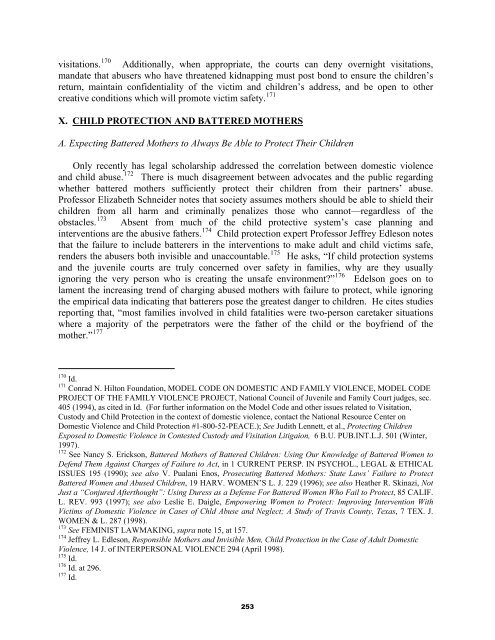A Judge’s Guide
A Judge’s Guide
A Judge’s Guide
You also want an ePaper? Increase the reach of your titles
YUMPU automatically turns print PDFs into web optimized ePapers that Google loves.
visitations. 170 Additionally, when appropriate, the courts can deny overnight visitations,<br />
mandate that abusers who have threatened kidnapping must post bond to ensure the children’s<br />
return, maintain confidentiality of the victim and children’s address, and be open to other<br />
creative conditions which will promote victim safety. 171<br />
X. CHILD PROTECTION AND BATTERED MOTHERS<br />
A. Expecting Battered Mothers to Always Be Able to Protect Their Children<br />
Only recently has legal scholarship addressed the correlation between domestic violence<br />
and child abuse. 172 There is much disagreement between advocates and the public regarding<br />
whether battered mothers sufficiently protect their children from their partners’ abuse.<br />
Professor Elizabeth Schneider notes that society assumes mothers should be able to shield their<br />
children from all harm and criminally penalizes those who cannot—regardless of the<br />
obstacles. 173 Absent from much of the child protective system’s case planning and<br />
interventions are the abusive fathers. 174 Child protection expert Professor Jeffrey Edleson notes<br />
that the failure to include batterers in the interventions to make adult and child victims safe,<br />
renders the abusers both invisible and unaccountable. 175 He asks, “If child protection systems<br />
and the juvenile courts are truly concerned over safety in families, why are they usually<br />
ignoring the very person who is creating the unsafe environment?” 176 Edelson goes on to<br />
lament the increasing trend of charging abused mothers with failure to protect, while ignoring<br />
the empirical data indicating that batterers pose the greatest danger to children. He cites studies<br />
reporting that, “most families involved in child fatalities were two-person caretaker situations<br />
where a majority of the perpetrators were the father of the child or the boyfriend of the<br />
mother.” 177<br />
170 Id.<br />
171 Conrad N. Hilton Foundation, MODEL CODE ON DOMESTIC AND FAMILY VIOLENCE, MODEL CODE<br />
PROJECT OF THE FAMILY VIOLENCE PROJECT, National Council of Juvenile and Family Court judges, sec.<br />
405 (1994), as cited in Id. (For further information on the Model Code and other issues related to Visitation,<br />
Custody and Child Protection in the context of domestic violence, contact the National Resource Center on<br />
Domestic Violence and Child Protection #1-800-52-PEACE.); See Judith Lennett, et al., Protecting Children<br />
Exposed to Domestic Violence in Contested Custody and Visitation Litigaion, 6 B.U. PUB.INT.L.J. 501 (Winter,<br />
1997).<br />
172 See Nancy S. Erickson, Battered Mothers of Battered Children: Using Our Knowledge of Battered Women to<br />
Defend Them Against Charges of Failure to Act, in 1 CURRENT PERSP. IN PSYCHOL., LEGAL & ETHICAL<br />
ISSUES 195 (1990); see also V. Pualani Enos, Prosecuting Battered Mothers: State Laws’ Failure to Protect<br />
Battered Women and Abused Children, 19 HARV. WOMEN’S L. J. 229 (1996); see also Heather R. Skinazi, Not<br />
Just a “Conjured Afterthought”: Using Duress as a Defense For Battered Women Who Fail to Protect, 85 CALIF.<br />
L. REV. 993 (1997); see also Leslie E. Daigle, Empowering Women to Protect: Improving Intervention With<br />
Victims of Domestic Violence in Cases of Chld Abuse and Neglect; A Study of Travis County, Texas, 7 TEX. J.<br />
WOMEN & L. 287 (1998).<br />
173 See FEMINIST LAWMAKING, supra note 15, at 157.<br />
174 Jeffrey L. Edleson, Responsible Mothers and Invisible Men, Child Protection in the Case of Adult Domestic<br />
Violence, 14 J. of INTERPERSONAL VIOLENCE 294 (April 1998).<br />
175 Id.<br />
176 Id. at 296.<br />
177 Id.<br />
253


